Unum Group Bundle
Who Really Controls Unum Group?
Unraveling the ownership of a financial powerhouse like Unum Group is key to understanding its strategic moves and long-term vision. From its humble beginnings to its current status as a Fortune 500 company, Unum Group's journey is a testament to its resilience and adaptability. Knowing Unum Group SWOT Analysis helps you to understand the company better.
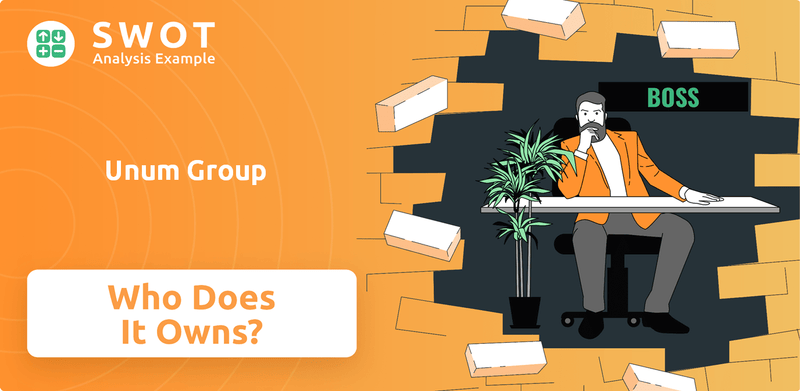
This exploration into Unum ownership will reveal the major players shaping the company's destiny, from institutional investors to individual Unum shareholders. Understanding who owns Unum is vital for anyone seeking to navigate the complexities of the insurance industry and assess Unum Group's financial performance. We'll also examine the evolution of the Unum company, including its mergers and acquisitions, and how these events have influenced its corporate structure and leadership team.
Who Founded Unum Group?
The story of Unum Group begins with its roots in the 19th century. Understanding the founders and early ownership provides crucial context for the company's evolution. This section will delve into the origins of key entities that form the foundation of what is known today as Unum Group, examining the initial ownership structures and key figures involved.
Unum Group's history is a tapestry woven from the incorporation of several key companies. The initial ownership dynamics of these foundational companies set the stage for the future. The early ownership structures and the transition to public ownership are critical to understanding the current Unum ownership landscape.
The foundational history of Unum Group starts with Union Mutual Life Insurance, which was incorporated in Maine in 1848. Elisha B. Pratt, the founder and president, received the first policy, a $5,000 life insurance policy on October 1, 1849. Initially, the company's principal office was in Boston, Massachusetts, but it later moved to Portland, Maine, in 1881.
The early ownership of Unum Group involved several key entities, each with its unique ownership structure. The evolution from mutual to public ownership significantly altered the shareholder base of Unum. Understanding these transitions is vital for a comprehensive view of the company's ownership.
- Union Mutual Life Insurance: Founded in 1848, it operated as a mutual insurance company for many years. Specific details on early equity splits are not readily available in public records.
- Provident Life and Accident Insurance Company: Founded in 1887, Thomas Maclellan and John McMaster acquired a 50% stake in 1892 for $1,000 and bought out the other owners by 1895.
- Masonic Protective Association (MPA): Founded in 1895, later became The Paul Revere Life Insurance Company, initially serving Masons.
- Demutualization: Union Mutual demutualized in 1986, becoming a publicly held company named Unum Corporation, and began trading on the New York Stock Exchange in November 1986. This shift changed the Unum ownership structure from policyholder to public shareholder ownership. For more insights, explore the Growth Strategy of Unum Group.
Unum Group SWOT Analysis
- Complete SWOT Breakdown
- Fully Customizable
- Editable in Excel & Word
- Professional Formatting
- Investor-Ready Format
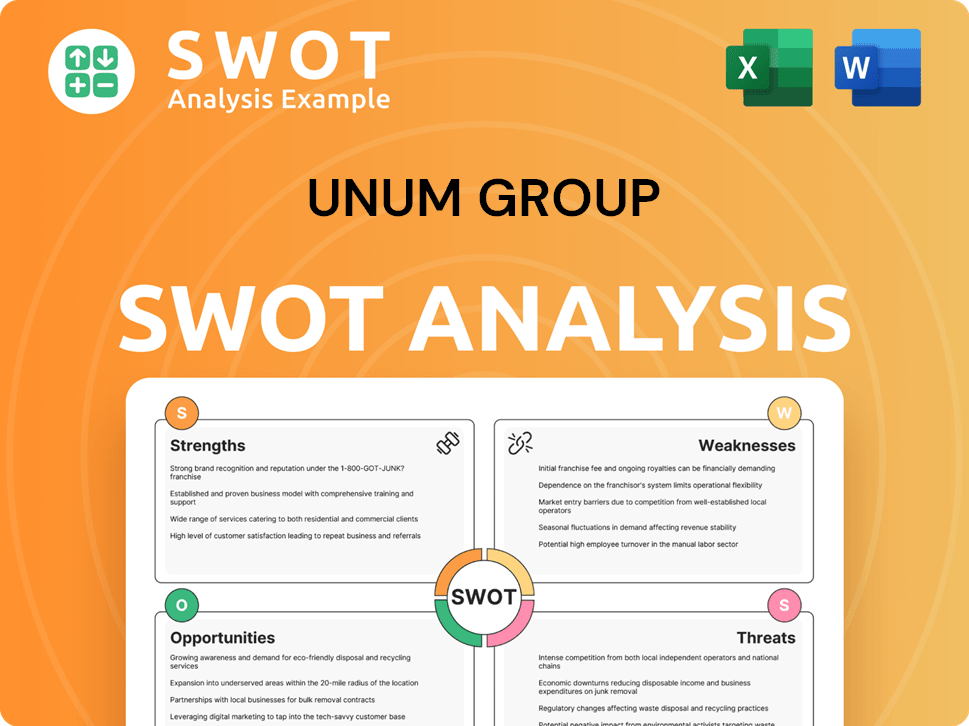
How Has Unum Group’s Ownership Changed Over Time?
The evolution of Unum Group's ownership has been shaped by key milestones. The company, initially known as Unum Corporation, went public on November 6, 1986. A pivotal moment was the 1999 merger of Unum Corporation and The Provident Companies, which created UnumProvident Corporation, then the largest disability insurance provider in the U.S. This entity was later rebranded as Unum Group in 2007.
As a publicly traded entity, Unum Group's ownership structure is primarily influenced by institutional investors. Their substantial holdings significantly impact the company's stock performance. Understanding who owns Unum is crucial for investors and stakeholders alike, as it provides insights into the company's stability and strategic direction. For more on the company's marketing approach, see the Marketing Strategy of Unum Group.
| Shareholder | Shares Held (as of March 31, 2025) | Approximate Percentage |
|---|---|---|
| The Vanguard Group, Inc. | Data not available | 12% |
| Blackrock, Inc. | 17,668,497 | Data not available |
| Norges Bank (as of December 31, 2024) | 13,746,646 | Data not available |
Institutional investors collectively hold approximately 81% of Unum Group's stock as of March 25, 2025. The top 11 shareholders control 50% of the business. Insider ownership is about 1.19% according to recent TipRanks data, and 0.96% as of May 2025. Retail and individual investors account for approximately 28.68% of the stock. As of June 13, 2025, Unum Group's market capitalization was $13.63 billion.
Unum Group's ownership is largely in the hands of institutional investors, influencing its stock performance and strategic decisions.
- The Vanguard Group, Inc. is a major shareholder, holding 12% of the shares.
- Insider ownership is a small percentage, reflecting the influence of company leadership.
- Retail investors also play a role in the company's ownership structure.
- Understanding Unum ownership provides insights into the company's financial stability.
Unum Group PESTLE Analysis
- Covers All 6 PESTLE Categories
- No Research Needed – Save Hours of Work
- Built by Experts, Trusted by Consultants
- Instant Download, Ready to Use
- 100% Editable, Fully Customizable
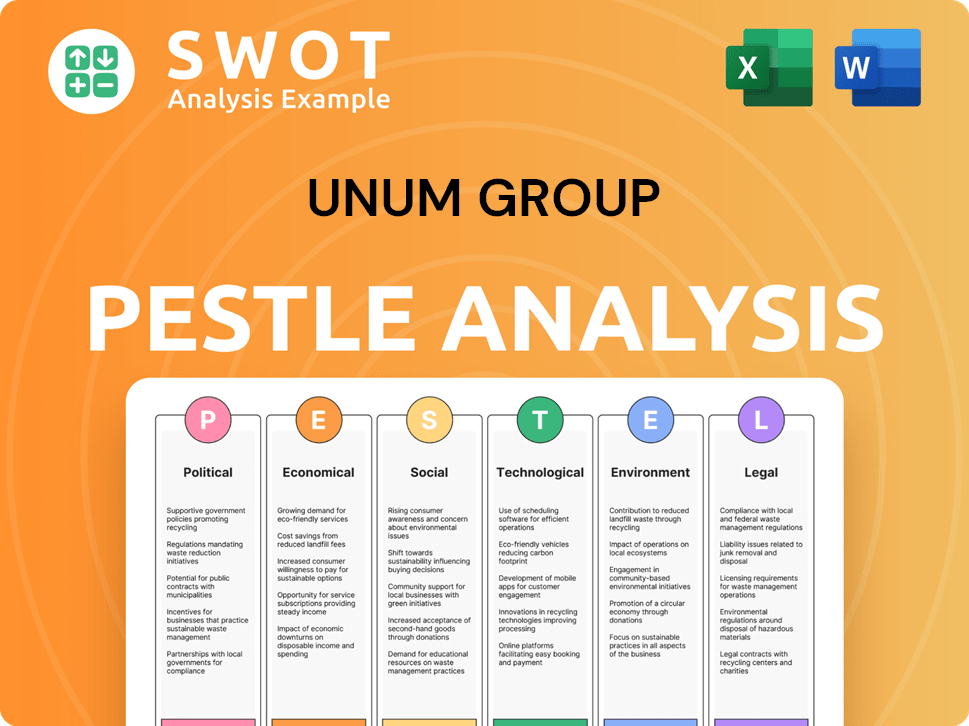
Who Sits on Unum Group’s Board?
The Unum Group's Board of Directors oversees the company's operations. The board's size, decided by a majority vote, can range from a minimum of three to a maximum of fifteen directors. As of June 10, 2025, the board includes Rick McKenney as President and CEO, and Kevin Kabat as the Independent Non-Executive Chairman. Other independent directors are Ronald O'Hanley, Timothy Keaney, Theodore Bunting, Susan Cross, Susan DeVore, Mojgan Lefebvre, Cynthia Egan, Joseph Echevarria, and Gale King.
The Unum Group's board has an average tenure of 10.2 years, suggesting considerable experience among its members. Richard McKenney, in his role as CEO, directly holds 0.43% of the company's shares. The company operates under a standard one-share-one-vote structure for its common stock, with no indications of dual-class shares or other arrangements that would grant disproportionate control to specific individuals or entities. For further insights, you can explore the Competitors Landscape of Unum Group.
| Board Member | Title | Ownership |
|---|---|---|
| Rick McKenney | President and CEO | 0.43% |
| Kevin Kabat | Independent Non-Executive Chairman | N/A |
| Ronald O'Hanley | Independent Director | N/A |
| Timothy Keaney | Independent Director | N/A |
| Theodore Bunting | Independent Director | N/A |
| Susan Cross | Independent Director | N/A |
| Susan DeVore | Independent Director | N/A |
| Mojgan Lefebvre | Independent Director | N/A |
| Cynthia Egan | Independent Director | N/A |
| Joseph Echevarria | Independent Director | N/A |
| Gale King | Independent Director | N/A |
The Board of Directors plays a vital role in managing Unum Group's business. The board can amend the company's By-Laws, and stockholders also have the power to do so with a majority vote. Each common stock share generally carries one vote, influencing the company's direction and decisions.
- The Board size ranges from 3 to 15 directors.
- Directors are elected until the next annual meeting or until successors are chosen.
- Stockholders can remove directors with a majority vote.
- The CEO directly owns a portion of the company's shares.
Unum Group Business Model Canvas
- Complete 9-Block Business Model Canvas
- Effortlessly Communicate Your Business Strategy
- Investor-Ready BMC Format
- 100% Editable and Customizable
- Clear and Structured Layout
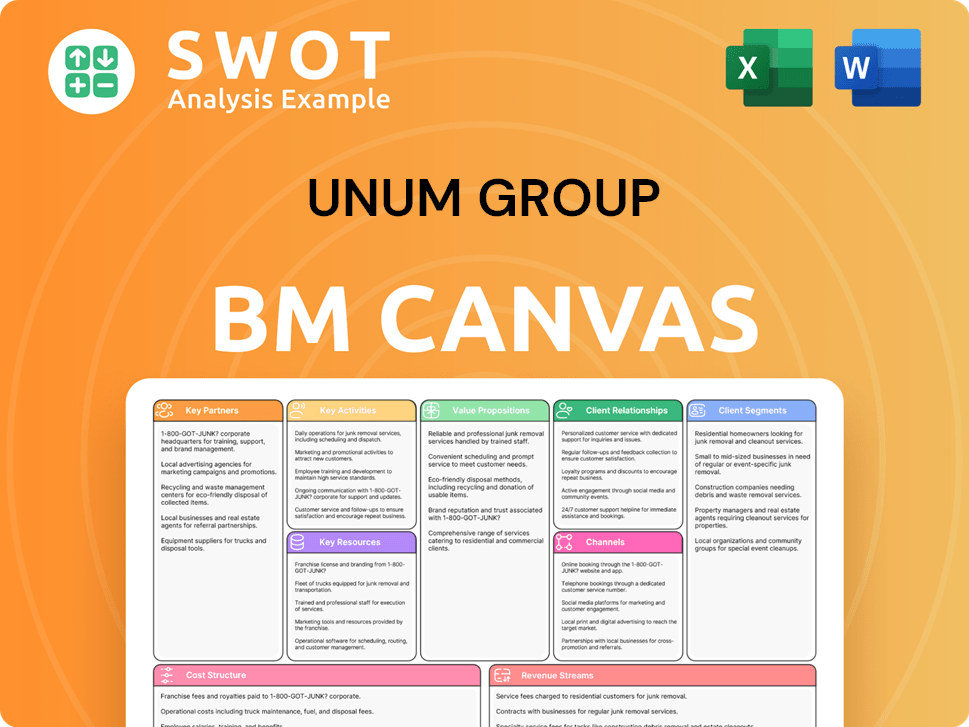
What Recent Changes Have Shaped Unum Group’s Ownership Landscape?
In the past few years, Unum Group has demonstrated a commitment to strategic financial management and returning capital to its shareholders. A notable development includes the authorization of a new share repurchase program of up to $1 billion, effective April 1, 2025, which replaced the previous program. Furthermore, the company announced a significant long-term care reinsurance transaction with Fortitude Re, effective January 1, 2025, ceding $3.4 billion of individual LTC reserves, indicating a focus on reducing exposure to legacy businesses and improving capital efficiency.
Regarding Unum ownership trends, institutional ownership remains a dominant factor. As of March 25, 2025, institutions held approximately 81% of Unum Group's stock. While insiders slightly increased their holdings from 0.95% to 0.96% in May 2025, institutional investors' holdings remained unchanged at 86.53%, and mutual funds' holdings remained unchanged at 63.68% in the same period. These figures highlight a stable ownership structure dominated by institutional investors. The company's board of directors authorized an approximate 10% increase in the quarterly dividend on its common stock in May 2025, raising it to 46 cents per share, reflecting positive financial performance.
| Metric | Value | Date |
|---|---|---|
| Institutional Ownership | Approximately 81% | March 25, 2025 |
| Insider Holdings | 0.96% | May 2025 |
| Dividend per Share | 46 cents | May 2025 |
| Net Income | $189.1 million | Q1 2025 |
| After-tax Adjusted Operating Income | $365.5 million | Q1 2025 |
The positive financial performance of Unum Group is further evidenced by its first-quarter 2025 results, with a net income of $189.1 million and after-tax adjusted operating income of $365.5 million. The company also provided a full-year 2025 outlook, projecting an increase in after-tax adjusted operating income per share of 6% to 10% compared to full-year 2024. This indicates a strong outlook for the Unum company and its ability to generate value for its shareholders.
Institutional investors hold a significant portion of Unum Group's stock, demonstrating a stable ownership structure.
Shareholders benefit from a commitment to returning capital, as seen with the share repurchase program and dividend increases.
The company's financial performance, including net income and after-tax adjusted operating income, supports a positive outlook.
Unum Group projects an increase in after-tax adjusted operating income per share of 6% to 10% for the full year 2025.
Unum Group Porter's Five Forces Analysis
- Covers All 5 Competitive Forces in Detail
- Structured for Consultants, Students, and Founders
- 100% Editable in Microsoft Word & Excel
- Instant Digital Download – Use Immediately
- Compatible with Mac & PC – Fully Unlocked
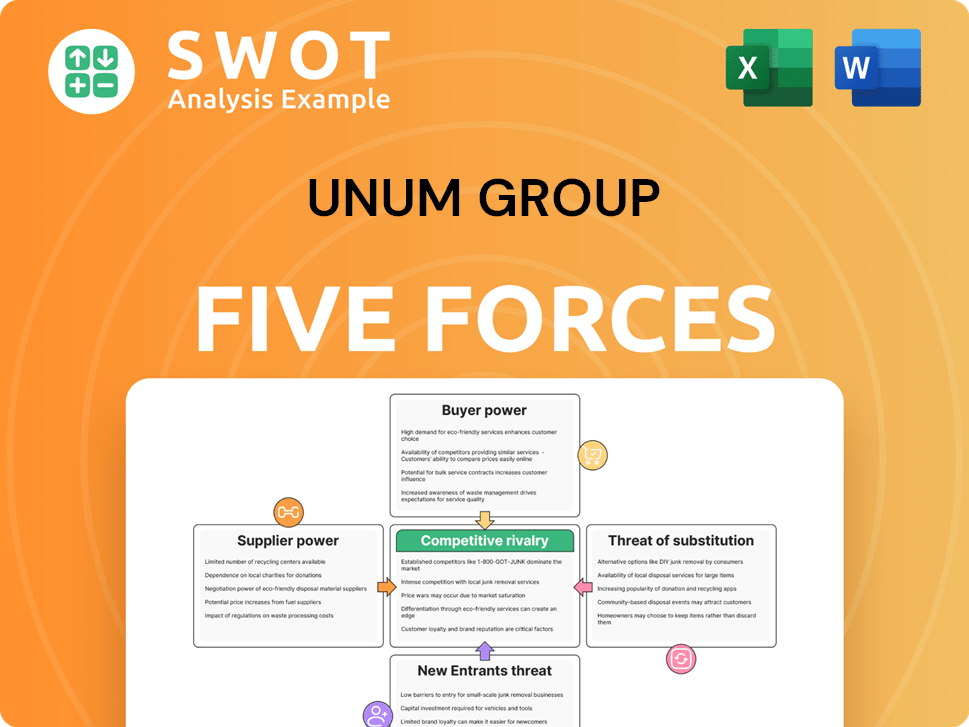
Related Blogs
- What are Mission Vision & Core Values of Unum Group Company?
- What is Competitive Landscape of Unum Group Company?
- What is Growth Strategy and Future Prospects of Unum Group Company?
- How Does Unum Group Company Work?
- What is Sales and Marketing Strategy of Unum Group Company?
- What is Brief History of Unum Group Company?
- What is Customer Demographics and Target Market of Unum Group Company?
Disclaimer
All information, articles, and product details provided on this website are for general informational and educational purposes only. We do not claim any ownership over, nor do we intend to infringe upon, any trademarks, copyrights, logos, brand names, or other intellectual property mentioned or depicted on this site. Such intellectual property remains the property of its respective owners, and any references here are made solely for identification or informational purposes, without implying any affiliation, endorsement, or partnership.
We make no representations or warranties, express or implied, regarding the accuracy, completeness, or suitability of any content or products presented. Nothing on this website should be construed as legal, tax, investment, financial, medical, or other professional advice. In addition, no part of this site—including articles or product references—constitutes a solicitation, recommendation, endorsement, advertisement, or offer to buy or sell any securities, franchises, or other financial instruments, particularly in jurisdictions where such activity would be unlawful.
All content is of a general nature and may not address the specific circumstances of any individual or entity. It is not a substitute for professional advice or services. Any actions you take based on the information provided here are strictly at your own risk. You accept full responsibility for any decisions or outcomes arising from your use of this website and agree to release us from any liability in connection with your use of, or reliance upon, the content or products found herein.